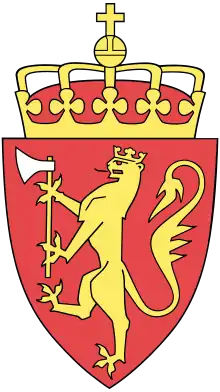Sandnes (city)
![]() Sandnes is a town in the far western part of the large Sandnes Municipality in Rogaland county, Norway. The town is located at the southern end of the Gandsfjorden and it makes up the southern part of the Stavanger/Sandnes metropolitan area, the 3rd largest urban area in Norway. The city of Sandnes is the administrative centre of the vast Sandnes Municipality which stretches from the city of Sandnes in the west to the border of Agder county, about 80 kilometres (50 mi) to the northeast.[3]
Sandnes is a town in the far western part of the large Sandnes Municipality in Rogaland county, Norway. The town is located at the southern end of the Gandsfjorden and it makes up the southern part of the Stavanger/Sandnes metropolitan area, the 3rd largest urban area in Norway. The city of Sandnes is the administrative centre of the vast Sandnes Municipality which stretches from the city of Sandnes in the west to the border of Agder county, about 80 kilometres (50 mi) to the northeast.[3]
Sandnes | |
|---|---|
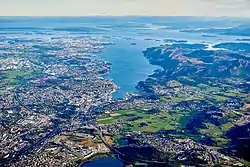 View of the town (in the foreground) | |
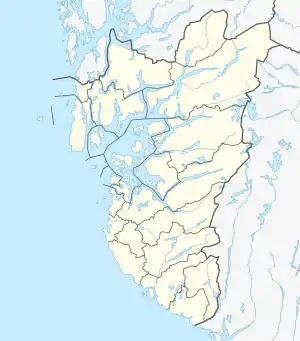 Sandnes Location of the town 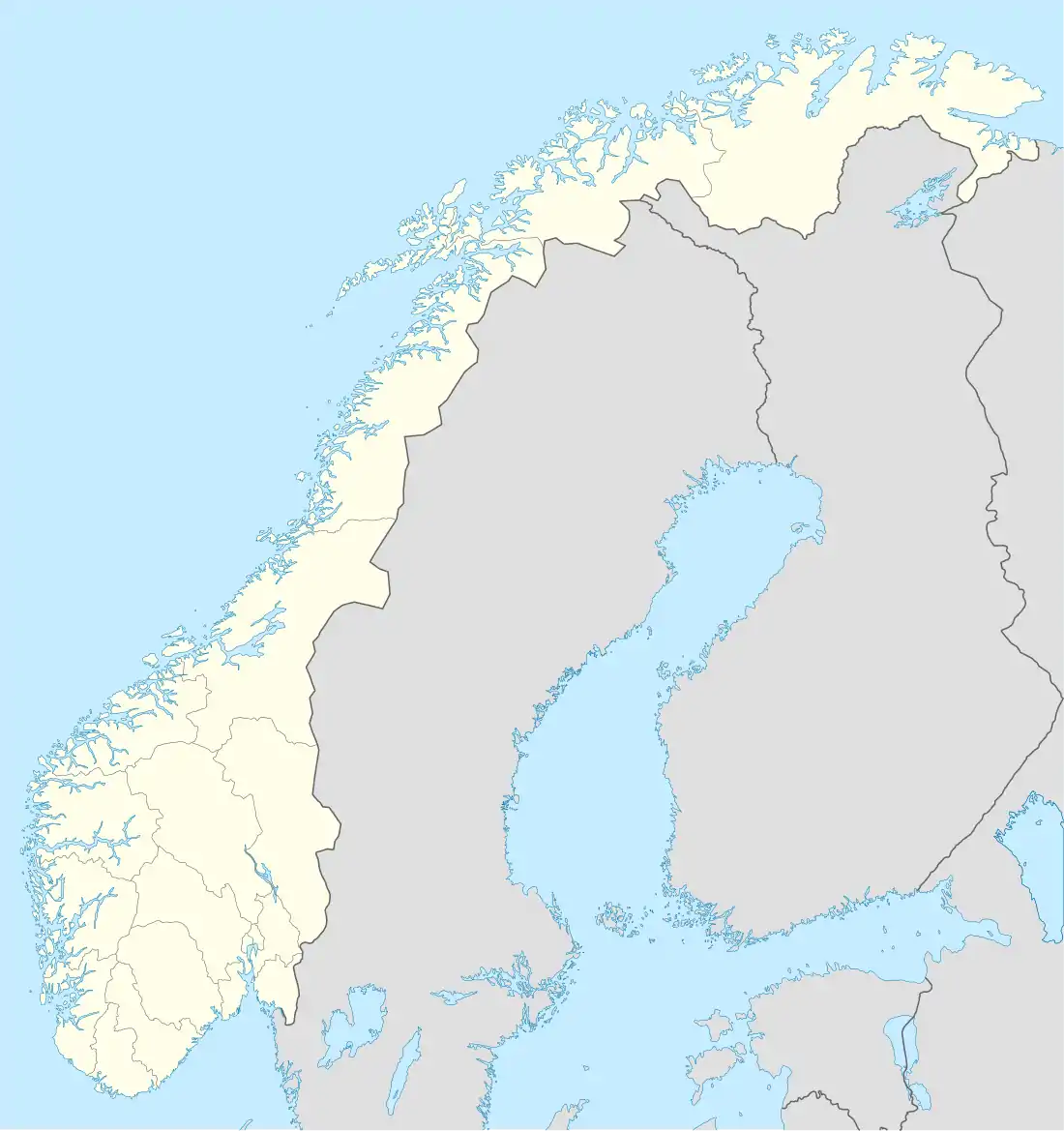 Sandnes Sandnes (Norway) | |
| Coordinates: 58.8509°N 5.7408°E | |
| Country | Norway |
| Region | Western Norway |
| County | Rogaland |
| District | Jæren |
| Municipality | Sandnes Municipality |
| Established as | |
| Ladested | 1860 |
| Area | |
| • Total | 23.35 km2 (9.02 sq mi) |
| Elevation | 2 m (7 ft) |
| Population (2019)[1] | |
| • Total | 63,375 |
| • Density | 2,714/km2 (7,030/sq mi) |
| Demonym(s) | Sandnesbu Sandnesgauk |
| Time zone | UTC+01:00 (CET) |
| • Summer (DST) | UTC+02:00 (CEST) |
| Post Code | 4306 Sandnes |
The 23.35-square-kilometre (5,770-acre) town has a population (2019) of 63,375 and a population density of 2,714 inhabitants per square kilometre (7,030/sq mi). Statistics Norway classifies the two neighboring cities of Sandnes and Stavanger as one large metropolitan area known as Stavanger/Sandnes, which has a total population of 228,287 residents. The city of Sandnes lies in the western part of the municipality and the city of Stavanger lies in the far southwestern part of that municipality.[1]
History

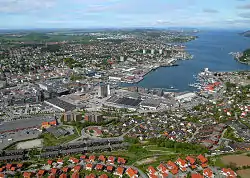
The small port village of Sandnes was granted ladested (small seaport city) status in 1860. On 6 April 1861, the small city was separated from the municipality of Høyland to form a separate self-governing municipality of its own. Initially, the municipality had 440 residents. On 1 July 1957, a small part of Høyland municipality (population: 18) was transferred to the city of Sandnes.
During the 1960s, there were many municipal mergers across Norway due to the work of the Schei Committee. On 1 January 1965, the city of Sandnes (population: 3,961) was merged with the municipality of Høyland (population: 20,353) and parts of the municipalities of Høle (population: 926) and Hetland (population: 2,077).[4]
Name
The city (and municipality) is named after an old "Sandnæs" farm, since the city was built on its grounds. The first element is sand which means "sand" or "sandy beach" and the last element is nes which means "headland". The farm was located at the end of the Gandsfjorden where the city centre is located today.[5]
Geography
The city lies in the Jæren region, at the base of the Stavanger Peninsula, about 15 kilometres (9.3 mi) south of the city of Stavanger, and these two cities have expanded so as to form a conurbation. The city of Sandnes makes up the western portion of the vast Sandnes municipality. The municipality of Sola is located to the west, the municipalities of Klepp and Time are to the southwest, and the municipality of Stavanger is to the northwest. The Gandsfjorden is situated north–south, terminating at the centre of the city. The international airport for Sandnes/Stavanger is situated in Sola, just to the west of Sandnes.
Media gallery
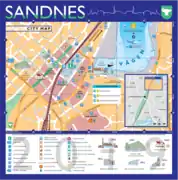 Map of Sandnes city center
Map of Sandnes city center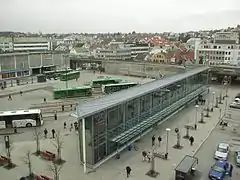 The bus station, known as Ruten (The Route)
The bus station, known as Ruten (The Route) Jæren Tingrett (District Court)
Jæren Tingrett (District Court)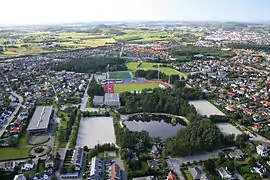 Sandnes sports park from the air
Sandnes sports park from the air Sandnes by night
Sandnes by night
Economy
The city of Sandnes hosts a large array of retail shops of most kinds and is used by the neighbouring municipalities appreciating the service and wide range of selections. Sandnes is known as Norway's bicycle city, mainly due to the fact that the bicycle manufacturer Øglænd DBS was situated here for decades. The city offers a variety of routes for everyday riders and tourists. Since 1996, a public bicycle rental program has been in operation in the city.

The city has a vibrant industrial base, mainly in the Ganddal area in the south and the Lura and Forus area in the north along the municipal boundary with Stavanger. There is significant activity related to oil exploration in the North Sea and also some IT related companies. In this suburban region between Sandnes and Stavanger, malls and department stores have also been established. Among these malls is one of Norway's biggest malls, Kvadrat meaning "square" (although it is not square shaped anymore as it has expanded several times since it opened in 1984).
Sandnes was formerly known as the pottery town of Norway – due to the important ceramics industry based on the extensive occurrence of clay in the surroundings. The Vatneleiren military base is also located in Sandnes, just outside Vatne on the eastern edge of the urban city of Sandnes.
Culture and sports
Since 2016, the primary football team, Sandnes Ulf, has played in the second tier, 1. divisjon, of Norwegian professional football.
The major tourist attraction in Sandnes is the Science Factory (Vitenfabrikken). It is a 4,000-square-metre (43,000 sq ft) science museum with science and art exhibitions, a planetarium, sun telescopes, and chemistry shows.
Sandnes is the only city in Norway which is a member of the World Health Organization’s network of Healthy Cities. Sandnes and Stavanger were chosen along with Liverpool, United Kingdom, to be a European Capital of Culture for 2008.
Higher education facilities include Forus Upper Secondary School, Sandnes Upper Secondary School, Gand Upper Secondary School, Akademiet Upper Secondary School and Lundehaugen Upper Secondary School. In 2010 Forus and Lundehaugen were no longer upper secondary schools; Lundehaugen is now a high school. Most of Forus and Lundehaugen merged into a new school named Vågen.
Sandnes is also known for its Rugby League team, Sandnes Raiders which has supplied the Norwegian national team with players.
The main church for the city is Sandnes Church, which is the seat of the Sandnes prosti, the deanery which covers the whole municipality.
See also
References
- Statistisk sentralbyrå (1 January 2019). "Urban settlements. Population and area, by municipality".
- "Sandnes (Rogaland)". yr.no. Retrieved 11 July 2020.
- Thorsnæs, Geir, ed. (8 June 2020). Store norske leksikon (in Norwegian). Kunnskapsforlaget https://snl.no/Sandnes_-_tettstedet. Retrieved 24 October 2020. Missing or empty
|title=(help) - Jukvam, Dag (1999). "Historisk oversikt over endringer i kommune- og fylkesinndelingen" (PDF) (in Norwegian). Statistisk sentralbyrå.
- Store norske leksikon. "Sandnes" (in Norwegian). Retrieved 7 April 2016.
External links
 Media related to Sandnes (city) at Wikimedia Commons
Media related to Sandnes (city) at Wikimedia Commons The dictionary definition of Sandnes at Wiktionary
The dictionary definition of Sandnes at Wiktionary Sandnes travel guide from Wikivoyage
Sandnes travel guide from Wikivoyage
